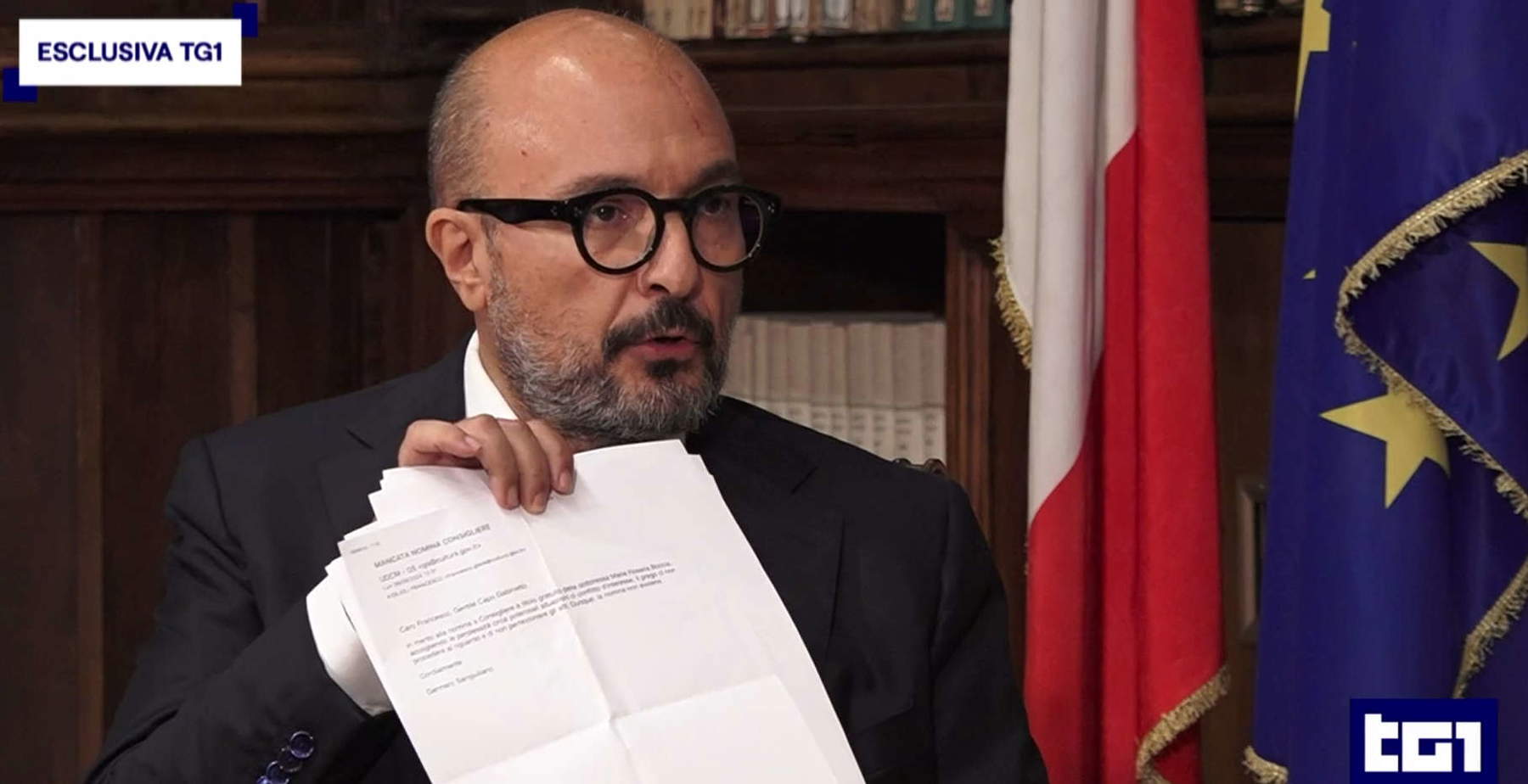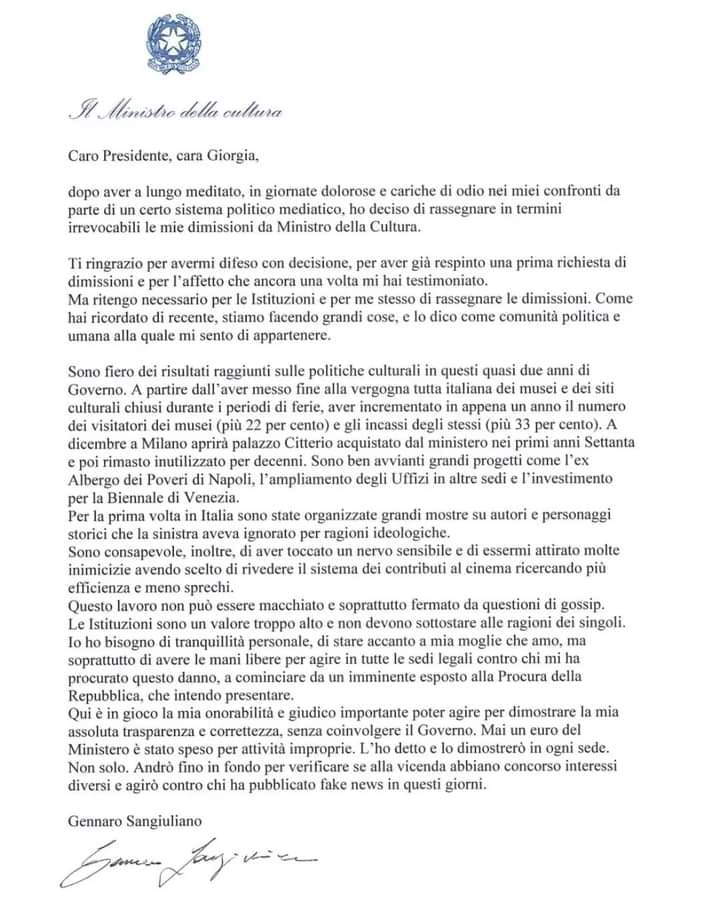The letter in which the now former minister Gennaro Sangiuliano resigned is interesting, beyond the typos and references to the affair that led to his decision to leave the Roman College, especially for the claims Sangiuliano squares in a half-page in which he offers citizens a summary of his work. It is interesting, in other words, because it offers an effective summary of what Sangiuliano perceives as his accomplishments in just under two years as minister of culture. What, then, has Sangiuliano left behind after these two years?
One could start precisely from the points listed in his letter, following the order he himself has given to his own achievements, which he enumerates proudly, declaring himself “proud” to have achieved them. The first, the former minister writes, is “having put an end to the all-Italian shame of museums and cultural sites closed during vacation periods.” It does not appear that previously museums closed for prolonged periods at the onset of public holidays, quite the contrary: the prerogative of announcing extraordinary openings during bridges and assorted holidays rather lumped him in with his predecessor Dario Franceschini. The only, real novelty was the opening of some state museums on Christmas Day, December 25, and in particular on December 25, 2023: the doors, that day, had to be opened on the basis of an agreement with the unions, although not all of them had adhered. And moreover, the Christmas openings were a flop (it will not be a coincidence that almost everywhere in Europe museums close on Christmas Day, and that even Italy until last year did not open museums on December 25), so much so that Sangiuliano, two days later, released the access figures, however, adding to the Christmas numbers also those of Boxing Day, a day that instead has always traditionally attracted many visitors to museums. If the former minister, on the other hand, alludes to the Easter and Ferragostan openings, no news: Franceschini, too, has often guaranteed extraordinary openings on spring and summer holidays.


Continuing in his letter, the former minister claims to have “increased in just one year the number of visitors to museums (more 22 percent) and museum receipts (more 33 percent).” The double-digit increases are real, but Sangiuliano forgot to specify that 2022 was still a pandemic year: until April 1 two years ago, someone will remember, it was mandatory to show a green pass to enter museums, and even as of this date the requirement to wear an FFP2 mask had not disappeared. In short, it is rather easy to claim staggering increases if the comparison is made with a year when most museum visitors did not go to museums for fear of contracting Covid, or because they had not yet gotten used to going out after two years of more or less prolonged confinement: it is as if the winner of the 100-meter gold medal at the Olympics bragged that he ran faster than’ one of his Paralympic colleagues. The comparison, if anything, should be made with the years leading up to the pandemic, and one will discover decidedly smaller increases in visitors than Sangiuliano’s vaunted increases, as well as an increase in receipts that reflects, however an across-the-board price increase in museum admission fees, which have never in the history of state institutions been as expensive as in 2023, with the highest average cost/visitor ever (although it can be said, to break a lance in favor ofa minister who has often reiterated that it is right to charge more for museum tickets, that the increases have not caused contractions in the paying public, which means that the threshold beyond which visitors do not consider it worthwhile to visit museums has not yet been crossed, although there isincreasingly felt the need to adopt a suitable discount policy to truly encourage regular attendance by Italians, an issue that Sangiuliano never even touched on, however).
Again, Sangiuliano anticipates that “in December, Palazzo Citterio, purchased by the ministry in the early 1970s and then left unused for decades,” will open in Milan (the reopening, however, is the result of a journey over several years, about which little the former minister can claim), and he exhibits as his successes the fact that projects such as the expansion of the Uffizi , the Uffizi Gallery , and the projects such as the expansion of the Uffizi (another project that has been in the works for years), the former Albergo dei Poveri in Naples (the transformation of this site into a cultural center is another project that was started when Franceschini was minister, and it is, moreover, a project that has been strongly criticized), and the investment in the Venice Biennale (just in case the need was felt). Finally, Sangiuliano states that “for the first time in Italy major exhibitions have been organized on authors and historical figures that the left had ignored for ideological reasons.” The former minister is probably alluding to exhibitions such as the one on Tolkien at the National Gallery of Modern and Contemporary Art in Rome: well, never before Sangiuliano had we seen a minister so keenly interested, to put it mildly, in the exhibition agenda of a state museum, and so involved. An exhibition, moreover, passed off as a successful event by a long sequence of communiqués flaunting five-figure numbers: “30 thousand visitors in one month,” the first note read. Thank you: at GNAM there is no separate ticket office for exhibitions and museums, and the visitors to the Tolkien exhibition were none other than those who entered the museum during that period. And who were counted as visitors to the Tolkien exhibition, thus including in the roster all those who the Tolkien exhibition halls did not even see them in photographs, because perhaps they went to the museum to see something else.
There ends the list of claims the minister made in his resignation letter. Is that all? That is the question one might ask upon reading the meager missive. Of course not: Sangiuliano also stood out for many other actions on which he glossed over by addressing his reflections to “Dear President” and “Dear Giorgia.” Sangiuliano ’ s two-year term could be remembered as the two years of domestic economics applied to cultural heritage, as the two years in which state museums were considered from a reductively economistic perspective, in the worst sense of the term: Sangiuliano’s main concern, with a view to the goal of an improbable generalized self-financing of the institutes, has been to make museums profit according to elementary modalities, that is, without adopting flexible policies, modulating the offer on the basis of flows or the interests of the public, or seeking a more active and structured involvement of private individuals, but through the simplest making a profit from the heritage. One of the first measures, in this sense, was the now infamous Decree 161 (also known as the “Tarasco Decree” after the name of the head of the Ministry’s legislative office), which went on to regulate in a very rigid way the reproduction of images of cultural heritage, providing for a cumbersome system of fees that also went to affect the categories that until then had been entitled to free of charge: a heated debate ensued, some of which also took place in the pages of this journal, and which led, after a year of continuous discussion and heated protests, to a substantial change in the regulations. If a good part of the insiders were able to breathe a sigh of relief, the idea of a proprietary conception of the public cultural good, which found wide affirmation during the Sangiuliano biennium and which also appears anachronistic observing the most recent international orientations, has not disappeared. Mention has already been made, then, of the generalized increases on admission tickets to museums, and one could also add in this sense the introduction of the paid ticket to visit the Pantheon, perhaps the most famous action of Minister Sangiuliano, although it had already been discussed at length when Franceschini was minister. And compared to his predecessor, Sangiuliano also decided to maintain the institution of free Sundays, moreover judging as a “great achievement” the crowds that pour into museums on these occasions (when it is, if anything, the exact opposite as an indication of a problem). Moreover, the tendency for our museums’ masterpieces to go around the worldhas not stopped; on the contrary, with Sangiuliano there has been an intense continuation of these reckless policies of loans, almost always passed over under the radar, and which we have always criticized on these pages: they will thus remember thesenseless loan of about seventy jewels from the Capodimonte Museum to the Louvre, the many loans that with supreme generosity have been granted in recent months by the National Archaeological Museum in Naples (curious that Naples has never been so stripped of its masterpieces as during the government of’a Neapolitan minister), the shipment of Leonardo da Vinci’s Scapigliata to the Shanghai Museum, the presence of Caravaggio’s Bacchus at Vinitaly, and, most recently, the planned sending of theFarnese Atlas as a testimonial of Italian cultural heritage to the Osaka Expo 2025.
Is there anything positive? Perhaps yes: the reshaping of the bonus for 18-year-olds, for example, or the idea of raising tickets for all state museums by one euro for a set period to raise funds for the Romagna region that was flooded last year. On the other hand, it is probably too early to judge the so-called “Sangiuliano reform,” a restructuring of the ministry approved a few months ago (suffice it to say that new department heads were appointed only last July). The premises, however, do not bode well: the former minister’s reform has been criticized mainly for sanctioning the definitive separation of protection and enhancement (which have become two separate functional areas), for initiating a significant proliferation of autonomous museums, which have increased to more than sixty, and for reintroducing a departmental structure along the lines of the 2005 reform (minister at the time was Rocco Buttiglione: the departments were then eliminated the following year). Dependent on the departments will be the directorates-general: the measure has thus been criticized because it will lengthen the chain of command, making the ministerial structure heavier and exposing it to the risk of overlapping tasks and competencies, or, paradoxically, to the danger of watering down important sectors (the Directorate-General for Education and Research, for example, has been abolished and its prerogatives distributed among the new departments).
Two years, then, essentially colorless, during which the minister’s action did not mark any major break with the past: Gennaro Sangiuliano turned out to be, on the contrary, a minister who continued, albeit often in a pejorative way (at least in the opinion of the writer), the work of his predecessors, without distinguishing himself by a structural action of his own, or by introducing models and visions that will mark the years to come in a marked way. It is more likely that, in the imagination not only of Italians in general, but also of insiders, Sangiuliano’s memory will remain carved by his numerous gaffes and the affair that made him the first minister of the Meloni government to resign.
Warning: the translation into English of the original Italian article was created using automatic tools. We undertake to review all articles, but we do not guarantee the total absence of inaccuracies in the translation due to the program. You can find the original by clicking on the ITA button. If you find any mistake,please contact us.